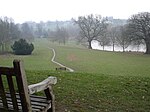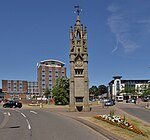St Nicholas Church, Kenilworth
Church of England church buildings in WarwickshireGrade I listed churches in WarwickshireHistory of WarwickshireKenilworthUse British English from June 2018

St Nicholas Church is a Church of England parish church in Kenilworth, Warwickshire, England. The church is built of local red sandstones. The main phases of building are Decorated Gothic, Perpendicular Gothic and a Gothic Revival Victorian restoration of 1864. It is a Grade I listed building.The church is a short distance south of the High Street, next to the Norman and Gothic ruins of St Mary's Abbey, over which much of the churchyard of St Nicholas now extends.
Excerpt from the Wikipedia article St Nicholas Church, Kenilworth (License: CC BY-SA 3.0, Authors, Images).St Nicholas Church, Kenilworth
High Street,
Geographical coordinates (GPS) Address Nearby Places Show on map
Geographical coordinates (GPS)
| Latitude | Longitude |
|---|---|
| N 52.3493 ° | E -1.5823 ° |
Address
St Nicholas
High Street
CV8 1LE , Abbey Fields
England, United Kingdom
Open on Google Maps







